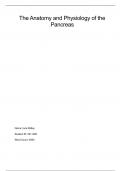The Anatomy and Physiology of the
Pancreas
Name: Iona Ridley
Student ID: 2011320
Word Count: 2000
, The pancreas is both an endocrine and exocrine organ located in the abdomen
(Pandiragan, 2018). This essay will explore the detailed anatomy of the pancreas, such
as its location, the anatomical regions it sits in, it’s blood supply, venous drainage and
where it is in relation to other organs, as well as both its endocrine and exocrine
physiology. This will be explored at both a molecular and gross level. The main function
of the exocrine pancreas is to produce pancreatic juices to help with digestion, while the
main function of the endocrine pancreas is to regulate blood sugar levels (Pandiragan,
2018). Production of pancreatic juices will maintain a healthy digestive system and help
to break down different foods that we eat into smaller molecules that the body can use.
Regulation of blood sugar is important to avoid hyperglycaemia and hypoglycaemia,
which can both have catastrophic effects on the patient if left untreated. This essay will
also briefly explore testing pancreatic function (Bockman, 2007). Exploring the anatomy
and physiology of the pancreas, as well as exploring how to test blood sugar levels will
provide a good understanding of a healthy pancreas.
The pancreas is a flat, lobulated, oblong shaped endocrine and exocrine organ,
yellowish in colour and 12-15 centimetres in length (Standring, 2016). This is supported
by Mahavedan (2016). It is a mostly retroperitoneal organ, deep within the upper
abdomen (Thompson 2020). The pancreas is commonly divided into the head, uncinate
process, neck, body and tail, and is situated on the transpyloric plane, in line with the
first lumbar vertebrae in the epigastric region with the tail leading into the left
hypochondriac region (Mahavedan, 2016). The thickest part of the pancreas is the
head, which is tucked into the C shaped curve created by the duodenum and is
attached to it by connective tissue (Thompson, 2020; Jones, 2020). The uncinate
process extends inferomedially, while the neck, body and tail extend towards the left,
becoming thinner and slightly more superior (Mahavedan, 2016). In relation to other
organs, the pancreas is inferior and posterior to the stomach (Standring, 2016) and
extends to the left, slightly rising upwards close to the hilum of the spleen. It is also
posterior to the liver and arches anteriorly around the aorta (Scanlon and Sanders,
2018). The lesser sac is situated between the pancreas and the posterior surface of the




